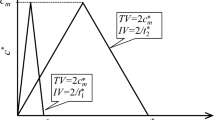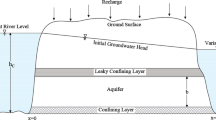Abstract
Using constant coefficients is an inefficient way to explain the details of the problem of pollutant transport. This is due to factors such as nonuniform geometry, discharge changes, flow velocity and dispersion coefficient variations. Previous studies indicate that the ratio of studies on pollutant transport in rivers is lower than those on the porous media. However, the relative complexity of the solution of the pollutant transport equation in rivers (especially in the case of variable coefficients) in comparison with porous media highlights the importance of focusing on the solutions for rivers environment. In this study, the one-dimensional equation of pollutant transport in the river with location-dependent variables (velocity, dispersion coefficient and cross-section area) with arbitrary pattern is solved via the generalized integral transform technique (GITT) in a finite-length domain and general initial and boundary conditions. In this study, the results obtained from the presented analytical solution are compared to those obtained from the existing analytical solutions in previous studies for the two states of constant and variable coefficients. To further test the accuracy of this method, we have compared the results obtained from the presented analytical solution with the results obtained from numerical solution based on finite-difference method by applying the conditions of two real rivers. Comparison of the results of the GITT verification with available analytical solutions as well as numerical solutions shows the high accuracy and the applicability of the proposed solution considering arbitrary patterns of the ADRE coefficients and general initial and boundary conditions.












Similar content being viewed by others
References
Abbott MB (1966) An introduction to the method of characteristics. Amrican Elsevier, North Holland. https://doi.org/10.1002/zamm.19670470519
Adrian DD, Yu FX, Barbe D (1994) Water quality modeling for a sinusoidally varying waste discharge concentration. Water Res 28(5):1167–1174. https://doi.org/10.1016/0043-1354(94)90204-6
Al-Niami ANS, Rushton KR (1979) Dispersion in stratified porous media: analytical solutions. Water Resour Res 15(5):1044–1048. https://doi.org/10.1029/WR015i005p01044
Chabokpour J, Minaei O, Dasineh M (2020) Derivation of new analytical solution for pollution transport through large porous media. Int J Environ Sci Technol 17:4703–4718. https://doi.org/10.1007/s13762-020-02766-1
Chen JS, Ni CF, Liang CP, Chiang CC (2008) Analytical power series solution for contaminant transport with hyperbolic asymptotic distance-dependent dispersivity. J Hydrol 362(1–2):142–149. https://doi.org/10.1016/j.jhydrol.2008.08.020
Chen JS, Chen JT, Liu CW, Liang CP, Lin CW (2011) Analytical solutions to two-dimensional advection–dispersion equation in cylindrical coordinates in finite domain subject to first-and third-type inlet boundary conditions. J Hydrol 405(3–4):522–531. https://doi.org/10.1016/j.jhydrol.2011.06.002
Chen JS, Liu CW, Liang CP, Lai KH (2012) Generalized analytical solutions to sequentially coupled multi-species advective–dispersive transport equations in a finite domain subject to an arbitrary time-dependent source boundary condition. J Hydrol 456:101–109. https://doi.org/10.1016/j.jhydrol.2012.06.017
Chen JS, Liang CP, Liu CW, Li LY (2016) An analytical model for simulating two-dimensional multispecies plume migration. Hydrol Earth Syst Sci 20(2):733–753. https://doi.org/10.5194/hess-20-733-2016
Chen JS, Ho YC, Liang CP, Wang SW, Liu CW (2019a) Semi-analytical model for coupled multispecies advective-dispersive transport subject to rate-limited sorption. J Hydrol 579:124164. https://doi.org/10.1016/j.jhydrol.2019.124164
Chen JS, Liang CP, Chang CH, Wan MH (2019b) Simulating three-dimensional plume migration of a radionuclide decay chain through groundwater. Energies 12(19):3740. https://doi.org/10.3390/en12193740
Cole AT, Abdulrahim A, Olayiwola RO, Shehu MD (2017) Analytical simulation of two dimensional advection dispersion equation of contaminant transport. J Appl Sci Environ Manag 21(5):827–832
Craig JR, Read WW (2010) The future of analytical solution methods for groundwater flow and transport simulation. In: Carrera J (ed) XVIII international conference on water resources CMWR 2010, pp 1–8
DHI (2012a) Scientific documentation, MIKE11: a modelling system for rivers and channels, reference manual. Danish Hydraulic Institute, Horsholm
DHI (2012b) Scientific documentation, MIKE11 - a modelling system for rivers and channels, short introduction tutorial. Danish Hydraulic Institute, Horsholm, Denmark
Djordjevich A, Savović S (2013) Solute transport with longitudinal and transverse diffusion in temporally and spatially dependent flow from a pulse type source. Int J Heat Mass Transfer 65:321–326. https://doi.org/10.1016/j.ijheatmasstransfer.2013.06.002
Djordjevich A, Savović S, Janićijević A (2017) Explicit finite-difference solution of two-dimensional solute transport with periodic flow in homogenous porous media. J Hydrol Hydromech 65(4):426–432. https://doi.org/10.1515/johh-2017-0040
El-Amin MF (2020) Analytical solutions of polymer transport in porous media under magnetic effect. Oil Gas Sci Technol Revue d’IFP Energies nouvelles 75:46. https://doi.org/10.2516/ogst/2020027
Fakouri B, Mazaheri M, Samani JMV (2019) Management scenarios methodology for salinity control in rivers (case study: Karoon River, Iran). J Water Supply Res Technol Aqua 68(1):74–86. https://doi.org/10.2166/aqua.2018.056
Fischer HB, List JE, Robert KC, Imberger J, Brooks NH (1979) Mixing in inland and coastal water. Academic Press, New York. https://doi.org/10.1002/iroh.19810660209
Guerrero JP, Skaggs TH (2010) Analytical solution for one-dimensional advection–dispersion transport equation with distance-dependent coefficients. J Hydrol 390(1–2):57–65. https://doi.org/10.1016/j.jhydrol.2010.06.030
Guerrero JP, Pimentel LCG, Skaggs TH, Van Genuchten MT (2009) Analytical solution of the advection–diffusion transport equation using a change-of-variable and integral transform technique. Int J Heat Mass Transf 52(13–14):3297–3304. https://doi.org/10.1016/j.ijheatmasstransfer.2009.02.002
Herman RL (2008) A second course in ordinary differential equations of dynamical systems and boundary value problems. Univ North C Wilmington 1:185–203
Hirsch C (2007) Numerical computation of internal and external flows: the fundamentals of computational fluid dynamics. Elsevier, Amsterdam. https://doi.org/10.1016/B978-0-7506-6594-0.X5037-1
Jaiswal DK, Kumar A, Kumar N, Yadav RR (2009) Analytical solutions for temporally and spatially dependent solute dispersion of pulse type input concentration in one-dimensional semi-infinite media. J Hydro-environ Res 2(4):254–263. https://doi.org/10.1016/j.jher.2009.01.003
Kangle H, van Genuchten MT, Renduo Z (1996) Exact solutions for one-dimensional transport with asymptotic scale-dependent dispersion. Appl Math Modell 20(4):298–308. https://doi.org/10.1016/0307-904X(95)00123-2
Kreyszig E (2009) Advanced engineering mathematics, 10th edn. Wiley, London
Kumar A, Jaiswal DK, Kumar N (2010) Analytical solutions to one-dimensional advection–diffusion equation with variable coefficients in semi-infinite media. J Hydrol 380(3–4):330–337. https://doi.org/10.1016/j.jhydrol.2009.11.008
Lai KH, Liu CW, Liang CP, Chen JS, Sie BR (2016) A novel method for analytically solving a radial advection-dispersion equation. J Hydrol 542:532–540. https://doi.org/10.1016/j.jhydrol.2016.09.027
Leij FJ, Van Genuchten MT (1995) Approximate analytical solutions for solute transport in two-layer porous media. Transp Porous Media 18(1):65–85. https://doi.org/10.1007/BF00620660
Li X, Wen Z, Zhu Q, Jakada H (2020) Flow transiency on analytical modeling of subsurface solute transport. Environ Sci Pollut Res 27(31):38974–38986. https://doi.org/10.1007/s11356-020-09628-w
Liu C, Ball WP, Ellis JH (1998) An analytical solution to the one-dimensional solute advection-dispersion equation in multi-layer porous media. Transp Porous Media 30(1):25–43. https://doi.org/10.1023/A:1006596904771
Liu C, Szecsody JE, Zachara JM, Ball WP (2000) Use of the generalized integral transform method for solving equations of solute transport in porous media. Adv Water Resour 23(5):483–492. https://doi.org/10.1016/S0309-1708(99)00048-2
O’Loughlin EM, Bowmer KH (1975) Dilution and decay of aquatic herbicides in flowing channels. J Hydrol 26(3–4):217–235. https://doi.org/10.1016/0022-1694(75)90004-9
Purkayastha S, Kumar B (2020) Analytical solution of the one-dimensional contaminant transport equation in groundwater with time-varying boundary conditions. ISH J Hydraul Eng 26(1):78–83. https://doi.org/10.1080/09715010.2018.1453879
Roshanfekr A, Kashefipour SM, Jafarzadeh N (2008) Numerical modelling of heavy metals for riverine systems using a new approach to the source term in the ADE. J Hydroinform 10(3):245–255. https://doi.org/10.2166/hydro.2008.056
Savović S, Djordjevich A (2012) Finite difference solution of the one-dimensional advection–diffusion equation with variable coefficients in semi-infinite media. Int J Heat Mass Transf 55(15–16):4291–4294. https://doi.org/10.1016/j.ijheatmasstransfer.2012.03.073
Savović S, Djordjevich A (2013) Numerical solution for temporally and spatially dependent solute dispersion of pulse type input concentration in semi-infinite media. Int J Heat Mass Transf 60:291–295. https://doi.org/10.1016/j.ijheatmasstransfer.2013.01.027
Stehfest H (1970) Algorithm 368: numerical inversion of Laplace transforms [D5]. Commun ACM 13(1):47–49. https://doi.org/10.1145/361953.361969
Van Genuchten MT (1985) Convective-dispersive transport of solutes involved in sequential first-order decay reactions. Comput Geosci 11(2):129–147. https://doi.org/10.1016/0098-3004(85)90003-2
Wang W, Dai Z, Li J, Zhou L (2012) A hybrid Laplace transform finite analytic method for solving transport problems with large Peclet and Courant numbers. Comput Geosci 49:182–189. https://doi.org/10.1016/j.cageo.2012.05.020
Yadav RR, Kumar LK (2018) Two-dimensional conservative solute transport with temporal and scale-dependent dispersion: analytical solution. Int J Adv in Math 2:90–111
Yates SR (1990) An analytical solution for one-dimensional transport in heterogeneous porous media. Water Resour Res 26(10):2331–2338. https://doi.org/10.1029/WR026i010p02331
Zamani K, Bombardelli FA (2014) Analytical solutions of nonlinear and variable-parameter transport equations for verification of numerical solvers. Environ Fluid Mech 14(4):711–742. https://doi.org/10.1007/s10652-013-9325-0
Acknowledgements
The authors wish to thank all who assisted in conducting this work.
Funding
The authors did not receive support from any organization for the submitted work. The authors have no financial or proprietary interests in any material discussed in this article.
Author information
Authors and Affiliations
Corresponding author
Ethics declarations
Conflict of interest
The authors declare that they have no conflict of interest.
Additional information
Editorial responsibility: Senthil Kumar Ponnusamy.
Rights and permissions
About this article
Cite this article
Amiri, S., Mazaheri, M. & Bavandpouri Gilan, N. Introducing a new method for calculating the spatial and temporal distribution of pollutants in rivers. Int. J. Environ. Sci. Technol. 18, 3777–3794 (2021). https://doi.org/10.1007/s13762-020-03096-y
Received:
Revised:
Accepted:
Published:
Issue Date:
DOI: https://doi.org/10.1007/s13762-020-03096-y




